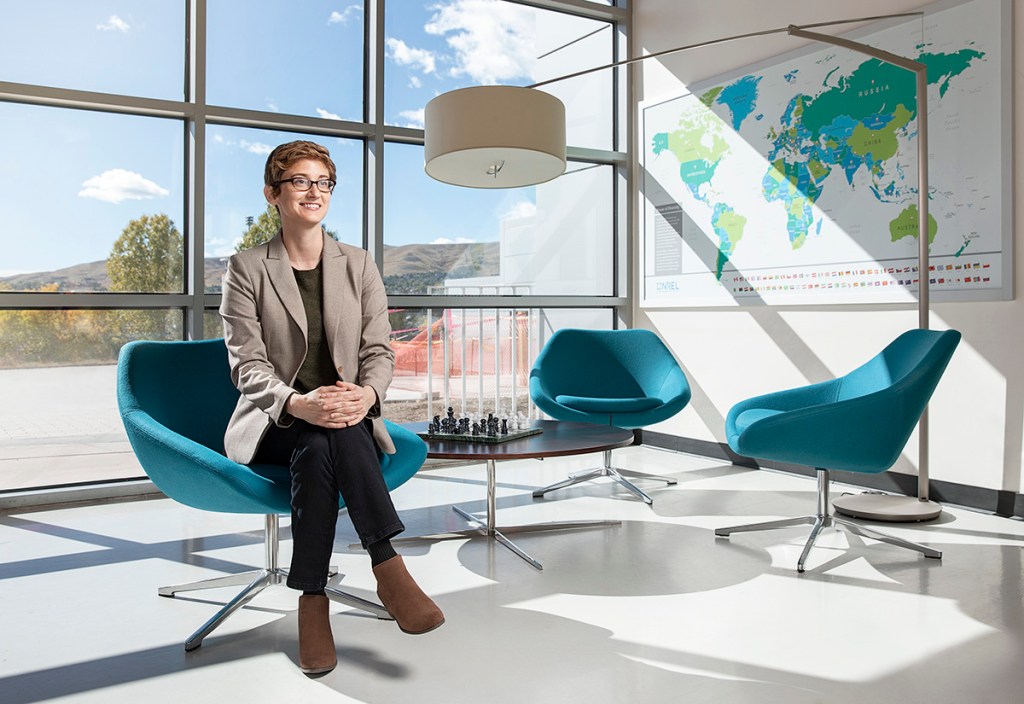On a Post-It note stuck to the wall of her office, Lena Burkett has written one of her aims in life: “Cut every American’s utility bill in half,” it reads. “I think that’s a reasonable goal,” says the bespectacled 34-year-old building scientist, who works to improve residential energy efficiency at the National Renewable Energy Laboratory (NREL) in Washington D.C.
THE NEXT GENERATION
Click here for profiles of four more young building scientists.
Specifically, Burkett provides technical research management for the DOE’s Building America program, which funds research in residential building science. One of two people with this role, she is a critical link that connects applied research with industry needs. Since joining the group in 2015, she has worked on 20 projects led by teams at academic institutions as well as research organizations including Home Innovation Research Labs, Southface, and Rocky Mountain Institute. “I make sure that the work is technically sound and the results will bring real value to the residential building industry,” she says. Findings on technologies such as advanced HVAC systems for low-load homes and whole-house air sealing using aerosol sealant are published on the Building America Solutions Center website, which builders can use to help meet or exceed code requirements in their projects.
“Lena’s deep understanding of building science, combined with her practical knowledge of residential construction and market needs, makes her uniquely qualified to help engineer the Building America research portfolio and effectively convey research findings to the industry,” says David Roberts, manager of NREL’s Residential Buildings Research Group.
Burkett, who was born and raised in Fort Worth, Texas, was a curious and outspoken child. She studied philosophy at Hendrix College, a small liberal arts school in Arkansas. “Philosophy seems very different from building science, but the research process is pretty similar,” says Burkett. “You have to understand the big picture as well as the minute logical details of a problem.”
Longing for a break from academia after graduation, she signed up with AmeriCorps and managed construction crews for a chapter of Habitat for Humanity. She then worked on a pilot program at the Clinton Climate Initiative that provided energy-saving improvements for low- and moderate-income homeowners, doing home energy audits and recommending upgrades. “It was very fulfilling to work on these homes, but it was one home at a time,” recalls Burkett. “I wanted to work on energy efficiency for all homes.”
To that end, she enrolled in a master’s in building science program at Appalachian State University in North Carolina. A highlight of her educational experience was participating in the DOE’s 2015 Race to Zero competition, in which student teams design a market-viable, net-zero-ready project. Her team proposed a single-family home with a flexible floor plan that enabled aging in place, and was named one of four finalists out of a field of 33.
At work, Burkett has a ringside view of the latest residential technologies under development. One of the teams she is working with, at the University of Minnesota, Twin Cities, is developing a solid-panel wall system that has no studs or cavities. The 8-foot-by-24-foot panels are made with cross-laminated engineered wood, a peel-and-stick membrane, and rigid insulation, creating a continuous thermal barrier and eliminating thermal bridging. “Builders are facing a shortage of skilled framing labor, so this system doesn’t rely so heavily on framers and there’s one contractor that does the whole envelope,” she explains.
The projects she works on often incorporate some aspect of resiliency, but enabling buildings that can handle extreme weather is in some sense intrinsic to the mission. “Resiliency luckily goes hand in hand with energy efficiency,” she says. “We have a very outdated grid, and a super-insulated home is going to be more survivable if the grid goes down.”
If she could fix just one problem, Burkett’s pick is unglamorous but deeply practical: automated commissioning for residential HVAC systems. “The more I dig into this topic, the more I learn how poor HVAC performance in the field can be,” she notes. “If we could develop technologies to not only monitor and identify faults but also automatically fix them, that would really change energy use as well as home comfort levels. We could also forecast when a replacement is needed. These systems tend to break on the hottest or coldest day, so it’s very difficult for both the homeowner and the contractor to take the time to investigate the options and come up with an optimized solution.” With her level of passion, Burkett makes it seem like any problem is solvable.



